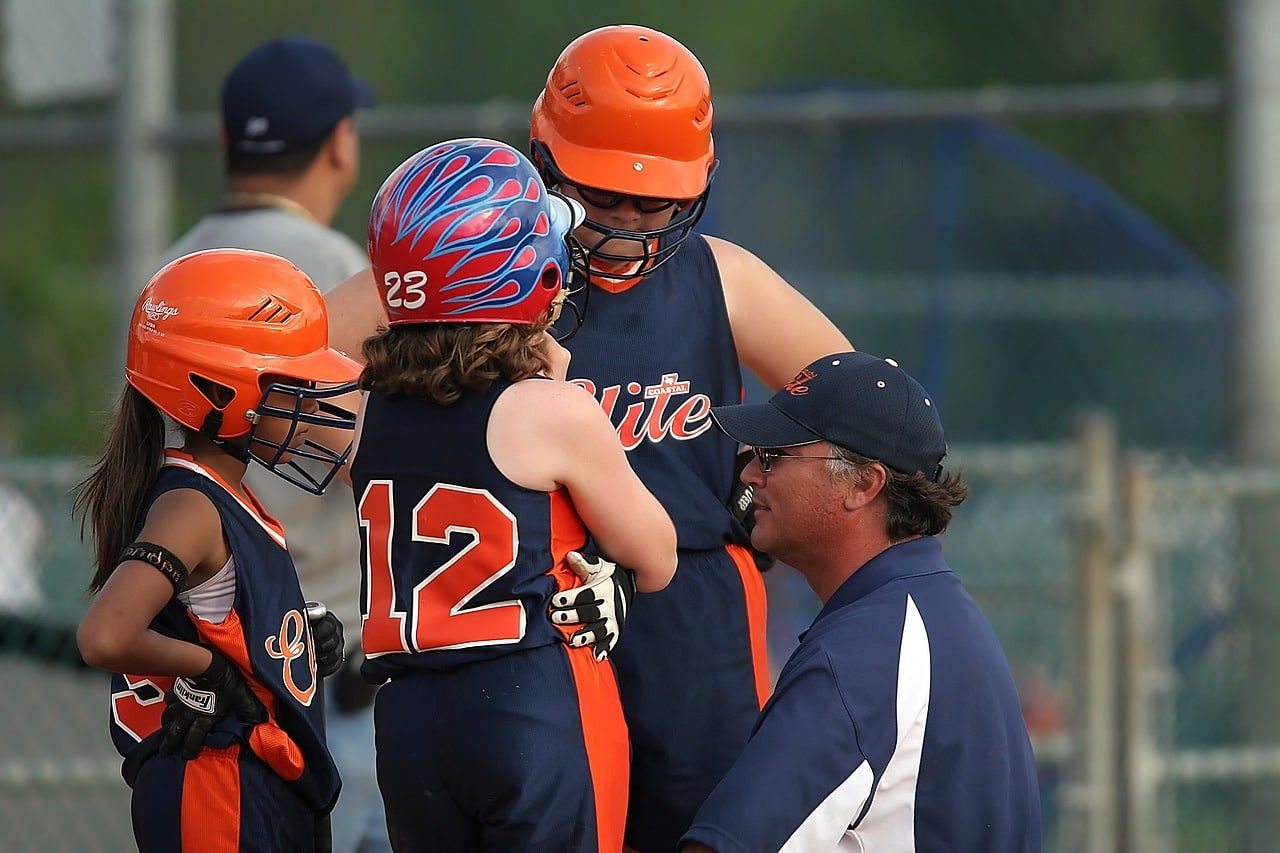Early recruiting is a hot topic of debate across all 24 NCAA sports. Families scratch their heads when they read the stories of kids verbally committing in the sixth grade. Everyone scrambles to follow new NCAA legislation that attempts to regulate early recruiting methods. And every student-athlete feels the pressure when it seems their whole team is committed before they even receive an offer. But what do current NCAA student-athletes have to say about the use of early recruiting?
Earlier this week, the NCAA Division I Student-Athlete Advisory Committee (SAAC) released results of a month-long study on the current trends of early recruiting. The complete results to the survey, which received over 15,000 responses, can be found on the NCAA’s website. Here, we will show you some of the key takeaways and break down what the results mean to you!
Note: this survey was completed by NCAA DIVISION I student-athletes and pertains to DI only.
At a Glance
- Section 1 → What does early recruitment mean for you?
- Section 2 → When are student-athletes receiving their first recruiting contact?
- Section 3 → When do verbal offers and verbal commitments occur in my sport?
- Section 4 → What can change when you decide to commit early?
- Section 5 → Additional resources
What Does Early Recruitment Mean For Me?
The results of this survey verify what everyone unofficially knew. Early recruiting happens. It happens more frequently in some sports than in others. And it will continue to happen despite the NCAA’s attempt to curb it. Early commitment is a rewarding, but potentially risky process.
If you are fortunate enough to be an early recruit for a Division I program, there are a few things to consider:
- Have you done your due diligence on the school? Is it the right academic, social, and geographic fit?
- Are you following other schools? What happens if a college coach leaves the program? Are you prepared?
- Would you be okay with decommitting? Verbal commitments mean very little to a college coach. You have free reign to change your mind until you sign your National Letter of Intent.

For those of you who are not early recruits for a Division I program, consider yourself fortunate as you get to complete your due diligence on the schools in your recruiting process. This due diligence includes:
- Awareness about when verbal offers and verbal commitments are made so you know how many spots remain on a roster.
- Thoroughly researching the schools you are interested in. Take a look at academics, athletics, and campus life.
- Developing relationships with college coaches to learn about team culture and coaching styles.
- Taking unofficial and/or official visits to the campus.
For some athletes, making your college choice as a freshman seems very premature. For others, it may be a decision you knew you’ve wanted for years. Whichever group you fall in, be sure to do your homework. Choosing a college isn’t a 4-year decision, it is a 40-year decision that impacts the rest of your life.
Timing Of First Recruiting Contact
In general, the recruiting process begins earlier for women than it does for men. This, of course, varies greatly by sport. In both men’s and women’s basketball, the recruiting process begins earlier than in any other sport. Softball, gymnastics, lacrosse, volleyball, and soccer student-athletes also tend to have their first recruiting contact very early in their high school career.
The graph below shows when male student-athletes had their first recruiting contact with a college coach.
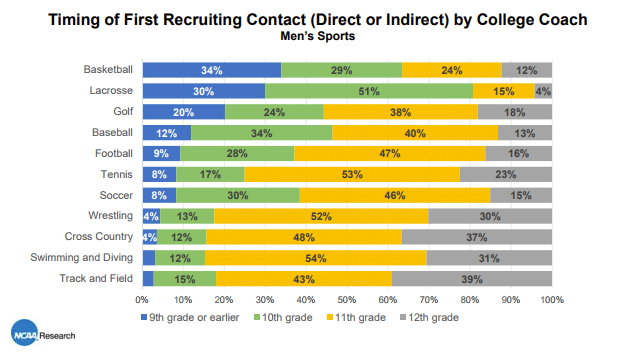
Similarly, this graph shows when female student-athletes had their first recruiting contact with a college coach.
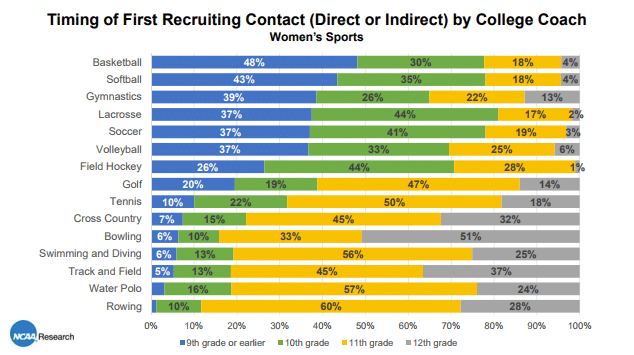
Keep in mind that while some sports certainly seem to begin the process early, there are still many student-athletes in all sports, especially in men’s sports, who did not have their first contact until 11th grade.
It should also be noted that the NCAA has passed new legislation in both men’s and women’s lacrosse that did not go into effect until this year. These changes did not affect the student-athletes who participated in this survey. Therefore, we can expect some changes in the recruiting timeline for men’s and women’s lacrosse, and in any other sport that adopts this legislation.
What does this mean for you?
Take a look at your sport. When are the majority of these student-athletes receiving their first recruiting contact from a college coach? If you have passed that point in your high school career and have not had your first contact, do not be too worried. Instead, use that as motivation to start messaging college coaches so your name gets across their desk.
Also, for those of you who are concerned about being late in the game, consider this:
This study also found that the later the recruiting process starts for an individual, the more positive it turns out to be!
Check out the correlation between an athlete’s positive recruiting experience and timing in this graph provided by the NCAA SAAC study.
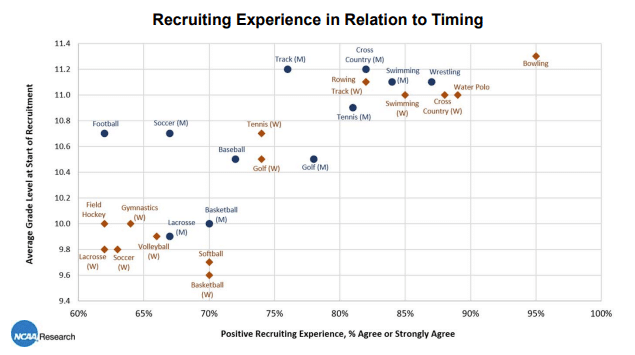
Generally, the earlier a recruiting process begins, the less positive that recruiting experience ends up being for the student-athlete. There is a positive correlation between a positive recruiting experience and a later start to the recruiting process.
Setting the foundation of your recruiting process early is very important. It is crucial to lay the framework by messaging college coaches and creating a list of target schools. However, deciding your commitment does not have to happen so early.
Making your decision later in your high school career allows you more time to research schools, take official or unofficial visits, and weigh your other options. You will be much more mature and well-informed as a junior or senior in high school compared to your freshman or sophomore year. Regardless of your class year, be sure to ask yourself if you have taken the steps necessary to get a good grasp on what you will get out of your future school.
Timing Of Verbal Offer Vs. Verbal Commitment
We just took a look at when student-athletes are receiving their first recruiting contact from a coach, but how does that compare to when student-athletes are receiving their first verbal scholarship offer?
In any sport, men’s or women’s, it is very rare to receive a verbal scholarship offer before your sophomore year. In fact, in every sport, the majority of student-athletes do not receive their first verbal offer until after the start of their junior year. Coaches of team sports seem to make their scholarship offers earlier than coaches of individual sports, who rarely make offers prior to senior year.
The graph below shows when student-athletes are receiving their first scholarship offer in men’s sports.
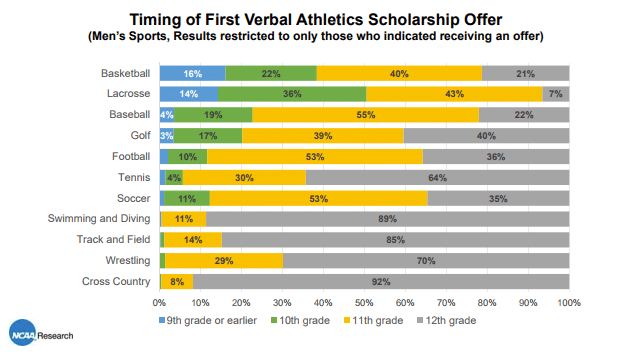
Here is the breakdown for when student-athletes are receiving their first scholarship offer in women’s sports.
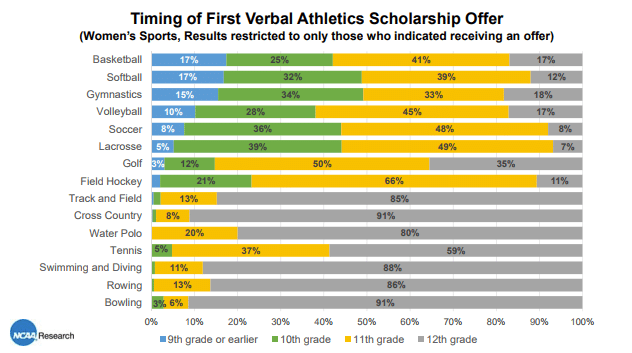
Above, we see when student-athletes are receiving their first offer. What does that look like compared to when they make their first verbal commitment?
Lacrosse takes home the early commitment crown here. Mid-to-late junior year is the average time period when lacrosse student-athletes make their verbal commitment to Division I Schools. Again, this study was completed by student-athletes who did not go through the new lacrosse recruiting legislation, which prevents any type of contact with a college coach prior to Sept. 1 of your junior year.
Student-athletes in other women’s sports have time periods similar to that of lacrosse for verbal commitments, while student-athletes in men’s sports tend to wait until early-to-mid senior year for that unofficial commitment.
Take a look at the chart below to learn the grade-levels in which student-athletes are making their first verbal commitments.
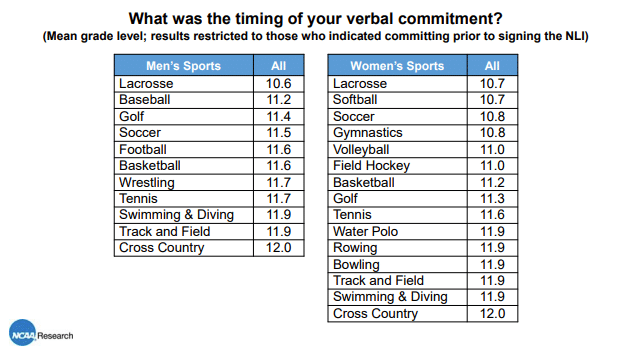
Use these values as a guideline for your process. Imagine your recruiting finish line (for Division I) is whatever grade level is listed above. Are you taking the necessary actions to set yourself up for a commitment by this date?
What does this mean for you?
These commitment dates should give you an idea of when student-athletes in your sport are receiving and verbally accepting offers from a college coach. There are exceptions to these numbers, but if you are well beyond the average grade level for your sport, then the remaining spots on a Division I roster will be very limited.
Take note that for many sports, the average verbal commitment date occurs before official visits are allowed for a student-athlete. The rules for some sports vary, but for the most part, official visits are not allowed until your senior year of high school. This means that in sports like lacrosse, softball, gymnastics, and women’s soccer, a lot of athletes are verbally committing before they take an official visit at that school. This shows the importance of the unofficial visit.
Take a look below to see when Division I prospects are taking their unofficial visits.
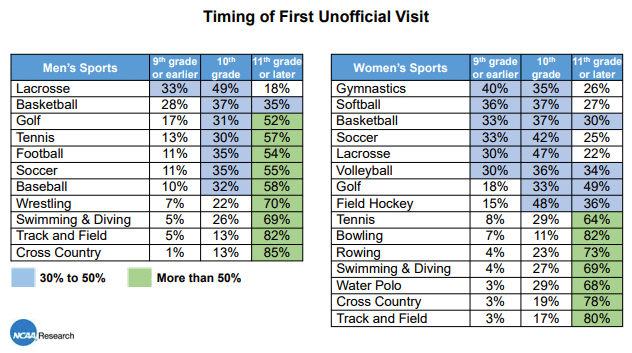
The sports with student-athletes who tend to have the earliest verbal commitments are also the sports in which prospects take unofficial visits earlier in their career. If you find yourself in the early recruitment process, consider the power of the unofficial visit. It is a great way to learn more about the schools you have been contacting with fewer restrictions than an NCAA official visit.
What Can Change When You Decide To Commit Early?
The idea of committing prior to your junior or senior year can certainly seem luxurious. You are removed from the stress of the recruiting process, you can focus on other things, and you can wear the swag from your future program around the halls of your high school. Unfortunately, early commitment brings just as much risk as it does reward.
Take a look at the chart below, which shows that an early commitment might not be as permanent as you think. Those who verbally commit early are less likely to end up at the college they commit to than those who verbally commit later in high school.
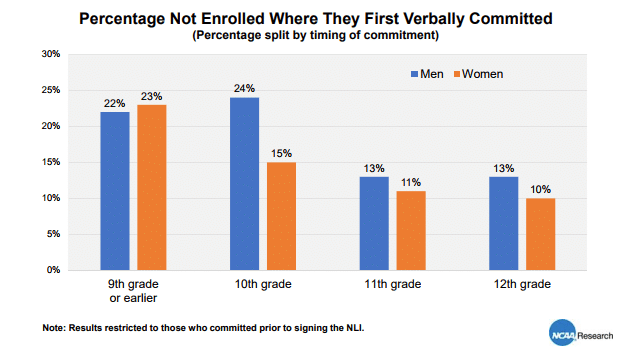
Student-athletes who make early verbal commitments tend to change their commitments much more frequently than those who wait until junior or senior year to verbally commit.
While an early commitment can be a great opportunity, student-athletes often do not do their due diligence with the schools they are getting offers from.
The graph below shows the lack of consideration many early prospects have in the academic side of the college decision process. Those who commit early are more likely to have done so with no academic major in mind than those who commit later in high school.
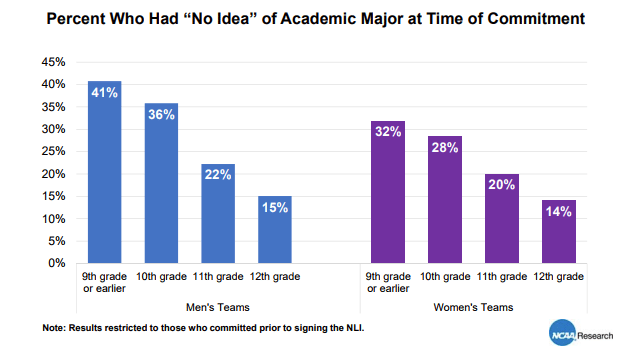
Remember, athletics should not be the only consideration in your college selection process. It is important to find a school where you will be happy as a student, not just as an athlete. If you suffered a career-ending injury, would you still pick that school?
The final risk of early commitment is that the head coach or your recruiting coach may leave before you even enroll in the school. College coaching is a very dynamic occupation. It is very common for college coaches to jump around multiple programs in a short period of time.
The graph below shows the likelihood of a committed student-athlete experiencing a head coaching change before they arrive for freshman year. College coaches leave programs for a variety of reasons. Student-athletes who commit early are more likely to experience a coach leaving before they reach that school.
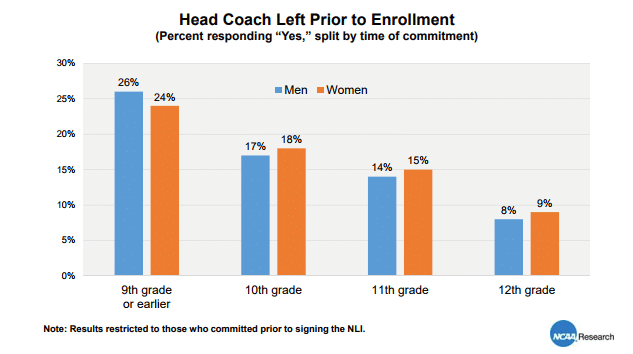
If you commit early and the coach who recruited you or made you a verbal offer leaves, there is no guarantee that your offer will still stand with that school. This can certainly throw your plans for a loop. If you are an early commit, be sure to keep up with the coaching staff. If things appear to be going south, you may want to consider reopening your options.
Additional Resources
The recruiting process in Division I begins earlier than in any other division. Whether you are an early recruit or a late recruit, be sure you are ready to commit when it comes time to make that decision. Below are some articles that will help you better understand how to stay on track with your recruiting process.
Recruiting Regulations And What They Should Mean To You →
Early Lacrosse Recruiting? Focus On You! →
When Can College Coaches Contact High School Athletes? →

Want More Recruiting Guidance?
Do you need additional resources or want more personal guidance throughout the recruiting process? We would love to chat with you about the SportsRecruits Insights Program and how it is helping families all across the country!
Schedule time on our calendar to learn how SportsRecruits Insights can help!
Talk to Sean |
Talk to Danny |


